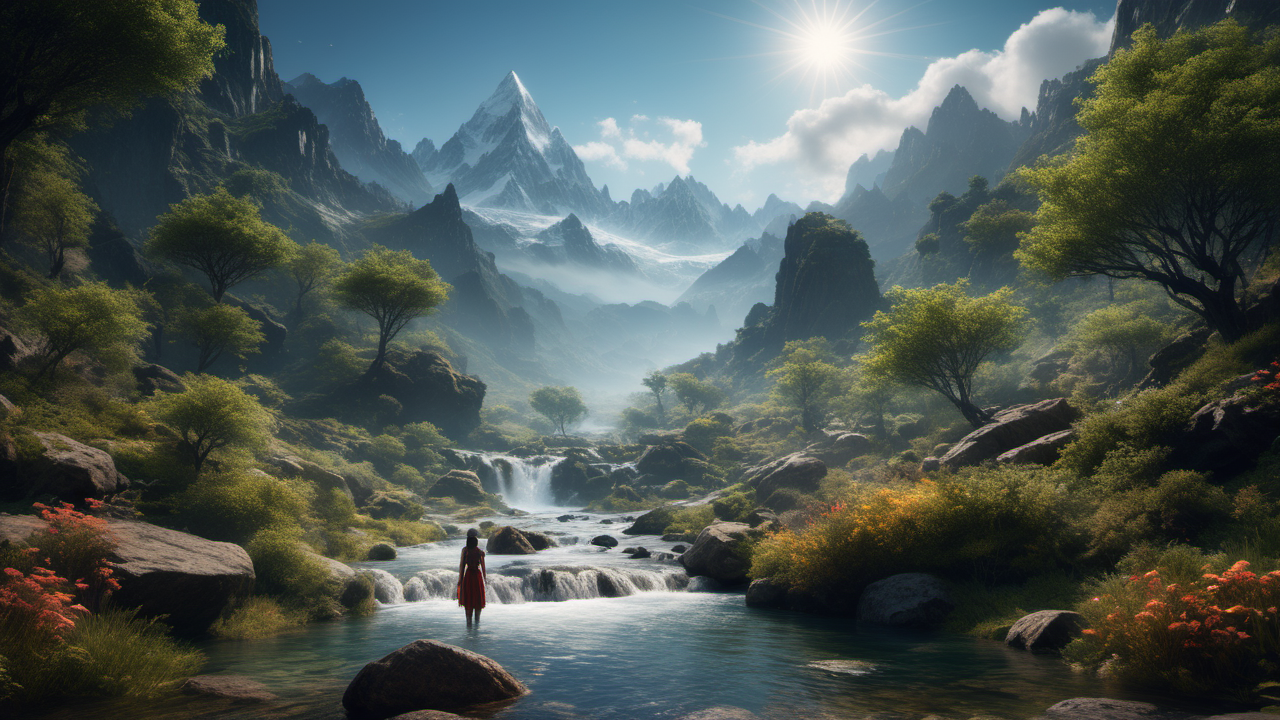Our planet is a stunning tapestry of diverse landscapes, each with its unique allure and charm. From the serene beauty of a sun-kissed beach to the breathtaking grandeur of towering mountain ranges, the world around us is a visual feast waiting to be captured. This article will take you on a journey through the captivating world of landscape photography, unveiling the beauty of nature in its rawest form. We will explore the diverse landscapes from around the globe, delve into the art and techniques of capturing these scenes, and gain insights from renowned landscape photographers. We will also look at the power of perspective and the beauty in diversity, and guide you on how to effectively use landscape stock photos in your projects. So, brace yourself for an immersive photo journey that celebrates the majesty and splendor of our natural world.
- 1. “The Captivating Allure of Landscape Photography”
- 2. “Exploring the Diverse Landscapes of the Globe: A Photo Journey”
- 3. “Unveiling Nature’s Masterpieces: Top Destinations for Landscape Photography”
- 4. “The Art of Capturing Nature: Techniques in Landscape Photography”
- 5. “The Power of Perspective: Interesting Angles in Landscape Photography”
- 6. “Beauty in Diversity: Landscape Photos of Different Climates and Seasons”
- 7. “Behind the Lens: Stories from Renowned Landscape Photographers”
- 8. “How to Use Landscape Stock Photos Effectively in Your Projects”
The Captivating Allure of Landscape Photography
Landscape photography holds a unique and captivating allure that is hard to deny. It’s a genre of photography that seeks to capture the breathtaking expanse of nature, in all its raw and untamed glory. Unlike other forms of photography, landscapes allow us to peer into places we may never get to visit, offering an intimate look at the stunning beauty our world has to offer.
The power of landscape photography lies in its ability to evoke emotions, inspire wanderlust, and elicit a profound appreciation for the natural world. It’s about capturing a moment in time, a brief snapshot that showcases the grandeur of nature in a single frame. Each photo tells a story, whether it’s of a serene beach at sunset, a rugged mountain peak shrouded in mist, or a vast desert under a starlit sky.
One of the fascinating aspects of landscape photography is its diversity. From the lush greenery of tropical rainforests to the stark beauty of arctic tundra, from the vibrant hues of a fall forest to the subtle pastels of a spring meadow, each landscape photo presents its own unique palette of colors, textures, and light.
Furthermore, landscape photography often transcends mere visual aesthetics. It can convey a sense of peace and tranquility, stir up feelings of awe and wonder, or even incite a desire for adventure. It’s not just about what we see, but how it makes us feel. It allows us to connect with nature on a deeper level, reminding us of our place in this vast, beautiful world.
This captivating allure of landscape photography is what makes it a popular choice for stock photos. These images can be used in a variety of ways, such as backgrounds for websites, promotional materials, or even as framed art, to infuse a touch of natural beauty into any space.
In conclusion, the allure of landscape photography extends far beyond the simple act of capturing a scenic vista. It’s about sharing the beauty of our world, opening our eyes to the wonders that surround us, and inspiring us to protect and cherish these natural treasures. As we explore landscape stock photos from around the world, we not only discover the incredible diversity of our planet, but we also experience the mesmerizing, captivating allure of nature itself.
Exploring the Diverse Landscapes of the Globe: A Photo Journey
Our planet is incredibly diverse, offering a vast array of different landscapes that are each uniquely beautiful. As we delve into our exploration of landscape stock photos from around the world, we embark on a captivating visual journey that unveils the stunning beauty of nature in all its forms.
From the arid, awe-inspiring expanse of the Sahara desert, with its shifting golden sands and endless blue sky, to the lush, vibrant jungles of the Amazon, teeming with a myriad of life and colors, our photo journey spans continents and climates. It’s a testament to the rich tapestry of natural wonders that our planet offers.
As we journey north, we encounter the majestic, icy wilderness of the Arctic, a world of white and blue where survival is a testament to the resilience of nature. Conversely, the sun-drenched savannahs of Africa, dotted with acacia trees and teeming with wildlife, present an entirely different, but no less compelling tableau.
The breathtaking grandeur of the Himalayas, the world’s highest mountain range, stands in stark contrast to the serene, rolling hills of the Tuscan countryside. The dramatic cliffs and azure seas of the Pacific coastline offer another facet of the world’s beauty, while the mystical, haunting beauty of the Scottish Highlands provides a glimpse into a landscape steeped in history and folklore.
Travel further and you’ll find the ethereal, alien landscapes of Iceland with its geysers and glaciers, the tropical paradise of the Maldives with its crystal-clear waters and pristine beaches, and the mesmerizing, otherworldly beauty of the Northern Lights.
As we journey through these diverse landscapes, we are reminded of the sheer scale and variety of our planet’s natural beauty. Each photograph tells a unique story of a place and time, capturing a single moment in the ever-changing tapestry of the Earth’s scenery.
This photographic journey serves not only as a testament to the beauty of our world but also as a reminder of the importance of preserving these landscapes for future generations. The diverse landscapes of the globe are a treasure to behold, a source of inspiration, and a reminder of the extraordinary planet we are fortunate to call home.
Unveiling Nature’s Masterpieces: Top Destinations for Landscape Photography
Nature is like an inexhaustible gallery of stunning masterpieces, each unique and breathtaking in its own way. Some places, however, stand out for their exceptional beauty, making them top destinations for landscape photography.
Firstly, Iceland, a surreal panorama of glaciers, geysers, waterfalls, and volcanoes, offers an unrivaled canvas for landscape photographers. The country’s ethereal allure is particularly pronounced during the winter, when the Northern Lights paint the sky with an array of vibrant colors. The famous Jökulsárlón glacier lagoon, the Seljalandsfoss waterfall, and the black sand beach of Reynisfjara are just a few of the many spots that capture the heart of every lens.
Next is the Banff National Park in Canada, a visual symphony of towering peaks, turquoise glacial lakes, and verdant forests. Moraine Lake, with its crystal clear waters reflecting the majestic Valley of the Ten Peaks, is one of the most photographed spots in the park. The Icefields Parkway, connecting Banff and Jasper National Parks, is a scenic route offering an endless array of captivating vistas.
The Atacama Desert in Chile is another photographer’s paradise. Being one of the driest places on Earth, its stark beauty is something out of this world. The otherworldly Valle de la Luna, the salt flats, the flamingo-populated lagoons, and the star-studded night skies make Atacama a unique backdrop for landscape photography.
The Scottish Highlands, with their rugged coastlines, deep lochs, and dramatic mountain landscapes, are a treasure trove of photographic opportunities. The mystical Isle of Skye, the haunting beauty of Glencoe, and the iconic Eilean Donan Castle are among the must-visit spots.
Finally, New Zealand’s South Island is a wonderland of diverse landscapes. From the serene beauty of Milford Sound, the golden beaches of Abel Tasman National Park, to the snow-capped peaks of the Southern Alps, the island offers a plethora of stunning scenes that beg to be captured.
Each of these destinations unveils nature’s masterpieces in a unique way, offering photographers the chance to capture the beauty of the planet in its raw, untamed form. So grab your camera, and let your journey to these picturesque landscapes inspire your creativity.
The Art of Capturing Nature: Techniques in Landscape Photography
Landscape photography is more than just clicking the shutter button; it is an art that requires patience, skill, and a deep understanding of the natural world. The essence of capturing striking landscape photos lies in the techniques applied, which can help to transform ordinary scenes into extraordinary images.
One of the foremost techniques in landscape photography is mastering the rule of thirds. This rule helps to create balance in the image, giving it a sense of harmony and allowing the viewer’s eyes to wander through the frame. The basic principle is to divide the image into thirds, both horizontally and vertically, and place the subject or important elements along those lines or at their intersections.
Timing also plays a crucial role in capturing nature’s beauty. The golden hour – the period shortly after sunrise or before sunset – provides the most beautiful light, casting a warm hue and creating long, dramatic shadows. The blue hour, the period before sunrise and after sunset, offers a different kind of beauty with cooler tones and softer light.
Depth of field is another critical technique in landscape photography. By adjusting the camera’s aperture, photographers can control the depth of field to keep everything from the foreground to the background in sharp focus. This is particularly useful in landscape photography as it allows you to capture every detail of the scene, from the blooming flowers in the foreground to the majestic mountains in the background.
Lastly, the use of leading lines can greatly enhance a landscape photo. Roads, rivers, or a row of trees can serve as leading lines, drawing the viewer’s eyes into the image and guiding them towards the main subject.
However, these techniques are just the starting point. The real art of capturing nature lies in the photographer’s ability to see the world in a unique way, to find beauty in the ordinary, and to convey their vision through their images. It’s all about connecting with nature and sharing that connection with others.
The Power of Perspective: Interesting Angles in Landscape Photography
Perspective plays a crucial role in landscape photography. It’s the secret sauce that can transform an ordinary scene into an extraordinary photograph. By changing the angle or the viewpoint from which a photo is taken, photographers can dramatically alter the perception and emotional impact of an image.
One of the most common perspectives in landscape photography is the wide-angle shot. This type of shot gives a broad view of a scene, making it perfect for capturing expansive landscapes such as open fields, sweeping mountain ranges, or wide rivers. Wide-angle shots often include a lot of the sky, which can add depth and colour to the image.
Another interesting angle often used in landscape photography is the bird’s eye view. This perspective, usually achieved through drone photography or from a high vantage point, gives a view of the landscape from above. This can create a sense of power and dominance and can reveal patterns and details that are not visible from the ground level.
Low angle shots, on the other hand, can add a sense of grandeur and scale to a landscape. By positioning the camera low and looking up, photographers can make elements in the foreground appear large and towering, which can create depth and interest in the image. This perspective can be particularly effective when photographing tall elements like trees or mountains.
A less common but equally striking perspective is the macro or close-up shot in landscape photography. Instead of capturing vast scenes, macro photography focuses on the smaller details in nature, like leaves, flowers, or insects. This perspective can reveal the beauty and complexity of nature that is often overlooked.
Finally, the use of reflections can also create interesting perspectives in landscape photography. Water bodies, like lakes or ponds, can mirror the landscape, creating symmetry and doubling the impact of the scene. This technique can create a serene and magical feeling.
In conclusion, the power of perspective in landscape photography lies in its ability to change the way we perceive the world around us. As photographers, the challenge lies in exploring these different angles and using them to reveal the hidden beauty of nature.
Beauty in Diversity: Landscape Photos of Different Climates and Seasons
The beauty of nature is manifold, and this is exceptionally evident when we explore the diversity found in landscape photography from different climates and seasons. These images encapsulate the essence of our planet’s astounding variety, each one telling a unique story.
In the tropical climate, landscape photos often portray an abundance of life and vibrant colors. The lush greenery of rainforests, the azure waters of tropical beaches, and the vibrant hues of exotic flowers and birds create a visual feast that is as breathtaking as it is diverse. Every image tells a story of growth, vitality, and the thriving life that warmth and ample rainfall can nurture.
Contrasting the tropical scenes, photographs from desert climates offer a starkly different but equally beautiful perspective. These landscapes may appear barren at first glance, but a closer look reveals a different kind of diversity. The endless sand dunes, dramatic rock formations, and resilient flora and fauna that manage to survive in such harsh conditions highlight nature’s tenacity and adaptability. The desert’s beauty lies in its vast, open spaces, its sense of solitude, and the remarkable sunsets that paint the sky in an array of pastel colors.
Moving towards the polar climates, the landscape photos capture a world where life exists against all odds. The stark white snowscapes, towering icebergs, and animals adapted to the cold create an imagery that is both ethereal and awe-inspiring. The Northern and Southern lights, a phenomenon unique to these regions, add a touch of mysticism to the polar landscapes.
Furthermore, the change of seasons adds another layer of diversity to landscape photography. From the fresh blossoms of spring, the lush greenery of summer, the warm hues of autumn leaves, to the serene white blanket of winter, each season brings with it a distinct palette and mood.
In conclusion, the beauty inherent in the diversity of our planet’s landscapes is boundless. Landscape photographs from different climates and seasons serve as a testament to the endless variations of beauty that nature offers, reminding us of the importance of preserving this precious diversity for generations to come. Whether it is the vibrant tropics, the austere desert, the enchanting poles, or the changing seasons, each presents a unique facet of the Earth’s remarkable beauty.
Behind the Lens: Stories from Renowned Landscape Photographers
Behind every mesmerizing photograph, there’s a story, a tale of adventure, patience, and the photographer’s unique perspective. These stories are often as captivating as the photographs themselves. Here, we delve into the experiences of some of the world’s renowned landscape photographers, exploring the stories behind their lens.
A name that stands out among landscape photographers is Ansel Adams, known for his black and white images of the American West. One of his most iconic works, “Moon Over Hernandez,” happened by chance. Adams and his companions were returning from a day of shooting when they saw the scene. As he hurried to set up his equipment, the light was fading rapidly. With no time to calculate the exposure, Adams relied on his experience and intuition. The result was a stunning photograph that encapsulated the beauty and tranquility of the scene.
Another inspiring story comes from landscape photographer Marc Adamus, known for his wilderness photography. One of his most significant images, “Land of the Light,” required persistence and an adventurous spirit. Adamus had to wait for the perfect moment when the sunlight would strike the remote Canadian Rockies’ peaks and create a magical aura. The result was a breathtaking photograph that required not just technical skills, but also patience and a deep connection with nature.
Then there is Galen Rowell, a wilderness photographer and climber who is remembered for his vibrant, dynamic images. His most iconic photograph, “Rainbow over the Potala Palace,” was not a result of sheer luck but a test of his skills and knowledge. He had predicted the rainbow’s occurrence by understanding the weather and light conditions. He raced against time, climbing a ridge to get the perfect angle before the rainbow faded. The outcome was a mesmerizing image that beautifully combined nature and culture.
Clyde Butcher, also known as the “Ansel Adams of the Everglades,” has a unique story for each of his photographs. One of the most striking is “Moonrise,” a photo that required him to be waist-deep in swamp water during the dusk. Despite the discomfort and danger, Butcher managed to capture the serene beauty of the night, proving that passion and dedication are crucial in landscape photography.
These stories are a testament to the adventure, patience, and connection with nature that landscape photography entails. The beauty we see in these photographs is a result of the photographers’ persistence, courage, and love for the natural world. It’s not just about being at the right place at the right time, but also about understanding the landscape, predicting changes, and being ready to seize the moment.
How to Use Landscape Stock Photos Effectively in Your Projects
Landscape stock photos can be an effective tool for adding visual interest and context to your projects. However, their use must be strategic and intentional to ensure they contribute positively towards your project’s objectives. Here are some tips on how to use landscape stock photos effectively in your projects.
1. Selection: Choose high-quality photos that align with your project’s theme or message. The photo should have a clear subject and should be able to stand alone in conveying a message or setting a mood.
2. Contextual Use: Always use landscape photos in context. They should complement the overall theme and not distract your audience from the main message.
3. Size and Resolution: Depending on where you plan to use the photo, pay attention to its size and resolution. For digital projects, a lower resolution might suffice, but for print, you need high-resolution photos to avoid pixelation.
4. Legality: Always ensure that the photos you’re using are licensed for your intended use. Breaching copyright laws can lead to hefty penalties.
5. Editing: Don’t be afraid to edit your chosen photos to make them fit better with your project. Cropping, adjusting color balance, or adding filters can often enhance the impact of a stock photo.
6. Balance: While landscape stock photos can be eye-catching, it’s important not to overuse them. Balance your use of images with text to ensure your message isn’t lost.
7. Consistency: Try to maintain a consistent aesthetic throughout your project. If you’re using a specific color scheme or style in your project, your chosen landscape stock photo should align with it for a more unified look.
8. Captions: Pair your landscape stock photos with effective captions. This not only provides context but also enhances user engagement.
Using landscape stock photos can breathe life into your projects, making them more engaging and visually appealing. However, strategic and thoughtful use is crucial to maximizing their potential.
Landscape photography, in its purest form, is an extraordinary testament to the myriad wonders of our planet. This form of art captures the captivating allure of nature, the diverse landscapes of the globe, and the unending beauty that nature has to offer. From learning about the techniques used in capturing these magnificent scenes to understanding how perspective can completely alter a picture’s impact, the world of landscape photography is as vast as the landscapes it captures. The variety of climates and seasons reflects the beauty in diversity and the stories behind each image add a personal touch, making them even more special. Ultimately, whether you’re an artist, designer, advertiser, or a lover of nature, using landscape stock photos effectively can significantly enhance your projects, transporting viewers to different parts of the world with a single glance. As we conclude, we hope you’re inspired to explore, appreciate, and utilize the enchanting beauty of landscape photography in all its glory.



